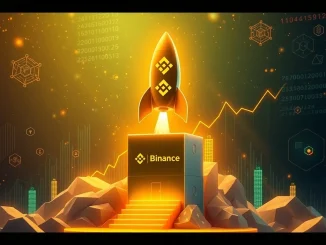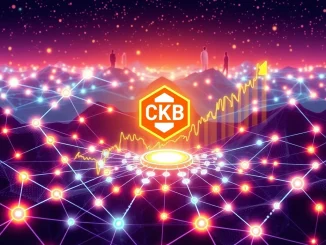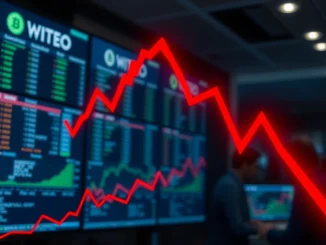
The world of decentralized finance (DeFi) is constantly evolving, bringing forth innovative solutions that aim to bridge the gap between traditional finance and blockchain technology. A significant leap in this journey comes from Midas, a prominent financial tokenization platform, which has just unveiled two new groundbreaking tokenized investment products: mMEV and mRe7YIELD. Launched on Etherlink, an Ethereum-compatible layer-2 platform, these offerings are set to redefine how investors engage with complex DeFi strategies, promising efficiency, accessibility, and reduced overhead. This move by Midas tokenized products signals a pivotal moment for crypto finance, pushing the boundaries of what’s possible in a decentralized ecosystem.
Understanding Midas’s New Tokenized Investment Products
Midas’s latest offerings, mMEV and mRe7YIELD, are more than just new tokens; they represent sophisticated financial instruments designed to provide streamlined exposure to diverse DeFi strategies. These products are built on the principle of tokenization, converting real-world or digital assets into blockchain-based tokens, making them more liquid, transparent, and accessible.
- mMEV: This product is designed to capture value from Maximal Extractable Value (MEV) strategies. MEV refers to the profit that can be extracted by reordering, inserting, or censoring transactions within a block. While often complex and requiring deep technical knowledge, mMEV aims to simplify participation, allowing investors to gain exposure to these high-potential, albeit intricate, strategies.
- mRe7YIELD: Focused on yield generation, mRe7YIELD likely taps into various DeFi protocols to optimize returns. This could include strategies like liquidity provision, staking, lending, or advanced yield farming techniques. The goal is to offer a diversified and managed approach to earning yield in the volatile DeFi landscape.
A crucial aspect highlighted by CoinDesk is the role of specialized asset managers: MEV Capital and Re7 Capital. These entities will be responsible for managing the underlying risks associated with each product. This professional oversight is vital in the often-unpredictable DeFi space, offering a layer of expertise and risk mitigation that individual investors might find challenging to replicate on their own. This partnership underscores a growing trend of institutional-grade management entering the decentralized arena, enhancing the credibility and safety of tokenized investment avenues.
The Strategic Choice: Why Etherlink Platform?
Midas’s decision to launch these products on Etherlink is highly strategic and speaks volumes about the evolving infrastructure of the blockchain world. Etherlink is an Ethereum-compatible Layer-2 (L2) platform, meaning it builds upon Ethereum’s security while addressing its scalability limitations.
Here’s why Etherlink is an ideal fit for these innovative tokenized products:
- Speed and Efficiency: Ethereum, while robust, can suffer from network congestion and slow transaction finality during peak times. Etherlink, as an L2, processes transactions off the main Ethereum chain, leading to significantly faster transaction speeds. For investment products that may involve frequent rebalancing or dynamic strategies, quick execution is paramount.
- Low Fees: High gas fees on the Ethereum mainnet have long been a barrier for many users, especially those with smaller capital. Etherlink dramatically reduces these transaction costs, making it more economical for investors to interact with Midas’s products, whether buying, selling, or managing their positions. This lower overhead directly translates to better net returns for users.
- Ethereum Compatibility: Being Ethereum-compatible means Etherlink benefits from the vast developer ecosystem, tooling, and liquidity already present on Ethereum. This ensures seamless integration with existing DeFi protocols and a familiar environment for developers and users alike. It leverages Ethereum’s battle-tested security model while providing the necessary performance boost.
- Scalability for Growth: As tokenized investment products gain traction, the underlying network must be able to handle increasing transaction volumes without degradation. Etherlink’s scalable architecture positions Midas to accommodate a growing user base and expand its product offerings in the future.
The choice of Etherlink highlights a broader industry trend: the maturation of L2 solutions. These platforms are becoming indispensable for applications that require high throughput and low costs, paving the way for more complex and capital-efficient DeFi strategies to flourish.
Unpacking DeFi Strategies and Their Potential
At their core, mMEV and mRe7YIELD are gateways to sophisticated DeFi strategies that have traditionally been inaccessible or overly complex for the average investor. Decentralized Finance (DeFi) is an umbrella term for financial applications built on blockchain technology, aiming to recreate traditional financial services in a decentralized, permissionless manner.
The potential of these strategies lies in their ability to generate yield and provide exposure to market inefficiencies in ways conventional finance cannot. However, they also come with inherent risks, including:
- Smart Contract Risk: Bugs or vulnerabilities in the underlying code of DeFi protocols can lead to loss of funds.
- Impermanent Loss: A risk for liquidity providers in automated market makers (AMMs) where the value of deposited assets can diverge from simply holding them.
- Liquidation Risk: In lending protocols, collateral can be liquidated if its value falls below a certain threshold.
- Market Volatility: The inherent volatility of cryptocurrencies can amplify gains or losses.
By packaging these strategies into tokenized products managed by expert teams like MEV Capital and Re7 Capital, Midas aims to mitigate some of these complexities for the end-user. Investors can gain exposure to potentially high-yielding DeFi opportunities without needing to understand the intricate mechanics of each protocol, manage gas fees for multiple transactions, or constantly monitor market conditions. This simplification is a game-changer for broader adoption, making sophisticated DeFi strategies accessible to a wider audience, from crypto natives to traditional investors looking to dip their toes into the digital asset space.
The Broader Impact on Crypto Innovation
Midas’s launch on Etherlink is more than just a product release; it’s a significant marker in the ongoing journey of crypto innovation. It represents a maturation of the tokenization trend, moving beyond simple asset-backed tokens to complex, strategy-backed financial instruments.
This development fosters:
- Increased Institutional Participation: The involvement of professional asset managers like MEV Capital and Re7 Capital, coupled with the robust infrastructure of Etherlink, provides a more familiar and secure framework for institutional investors who might be hesitant to engage directly with raw DeFi protocols.
- Enhanced User Experience: By abstracting away the complexities of gas fees, network congestion, and intricate DeFi mechanics, Midas makes these powerful strategies more user-friendly, reducing the barrier to entry for new participants.
- Liquidity and Capital Efficiency: Tokenized products can enhance liquidity for underlying strategies, allowing for easier entry and exit. The capital efficiency gained from lower fees on Etherlink also means more capital can be deployed into the actual strategies rather than being consumed by transaction costs.
- Standardization of DeFi Access: As more platforms offer similar tokenized access to DeFi, it could lead to a standardization of investment vehicles, making the decentralized financial ecosystem more understandable and navigable for a global audience.
This strategic move by Midas underscores the relentless drive within the blockchain space to innovate and build financial systems that are more open, efficient, and equitable. It’s a testament to the power of combining specialized expertise with cutting-edge blockchain technology to unlock new financial frontiers.
Challenges and Considerations for Tokenized Investment
While the launch of Midas’s tokenized products on Etherlink represents a significant step forward, it’s crucial to acknowledge the challenges and considerations that remain in this evolving landscape.
- Regulatory Scrutiny: As tokenized investment products gain traction, they inevitably attract the attention of regulators worldwide. The classification of these products (e.g., securities, commodities) and the regulatory frameworks applied to them are still developing. Uncertainty in this area can impact adoption and operational stability.
- Smart Contract Security: Despite audits and professional management, smart contract vulnerabilities remain a risk. Any flaw in the code underpinning the tokenized products or the underlying DeFi protocols could lead to significant financial losses. Continuous auditing and robust security practices are paramount.
- Market Risk: The inherent volatility of the cryptocurrency market means that even well-managed DeFi strategies are subject to market fluctuations. Investors must understand that while these products aim to optimize returns, they are not immune to market downturns.
- Decentralization vs. Centralization Trade-offs: While Etherlink offers decentralization benefits, the involvement of specific asset managers (MEV Capital, Re7 Capital) introduces a degree of centralization in the management layer. Understanding this balance is key for investors seeking pure decentralization.
- Education and Understanding: Despite efforts to simplify access, investors still need a foundational understanding of DeFi, tokenization, and the specific risks involved. Misinformation or lack of understanding can lead to poor investment decisions.
Addressing these challenges requires ongoing collaboration between developers, regulators, and the community to build a robust, secure, and transparent ecosystem for tokenized finance.
How to Engage with Midas’s Offerings
For those looking to explore Midas’s new tokenized investment products, the process typically involves a few key steps:
- Research: Thoroughly understand what mMEV and mRe7YIELD entail, including their underlying strategies, risk profiles, and the role of MEV Capital and Re7 Capital.
- Access Etherlink: Ensure you have a compatible wallet (like MetaMask) configured to connect to the Etherlink network. You will need to bridge funds (e.g., ETH) from the Ethereum mainnet to Etherlink.
- Acquire Tokens: Once on Etherlink, you can acquire mMEV and mRe7YIELD tokens through Midas’s platform or potentially through decentralized exchanges (DEXs) operating on Etherlink.
- Monitor and Manage: Keep track of your investment performance and any updates from Midas or the managing entities. Remember that while risks are managed, active monitoring is still advisable.
Always start with a small amount that you are comfortable losing and gradually increase your exposure as you gain more understanding and confidence. Diversification remains a key strategy in the volatile crypto market.
Summary: A New Horizon for Decentralized Finance
Midas’s launch of mMEV and mRe7YIELD on the Etherlink platform marks a significant milestone in the evolution of decentralized finance. By offering streamlined, tokenized access to complex DeFi strategies, Midas is lowering the barrier to entry for a wider range of investors. The strategic choice of Etherlink ensures that these products benefit from high speed and low fees, addressing critical pain points of the Ethereum mainnet. With professional risk management from MEV Capital and Re7 Capital, these offerings blend the innovative spirit of DeFi with a layer of institutional-grade oversight. This move not only enhances the accessibility of sophisticated DeFi strategies but also propels crypto innovation forward, paving the way for a more efficient, transparent, and inclusive financial future. As the ecosystem continues to mature, we can expect to see more such groundbreaking integrations that bridge the gap between cutting-edge blockchain technology and practical financial solutions.
Frequently Asked Questions (FAQs)
Q1: What are Midas’s new tokenized investment products?
Midas has launched two new tokenized investment products: mMEV and mRe7YIELD. These products offer simplified exposure to advanced decentralized finance (DeFi) strategies, with mMEV focusing on Maximal Extractable Value (MEV) strategies and mRe7YIELD targeting diversified yield generation opportunities.
Q2: Why did Midas choose Etherlink for this launch?
Midas chose Etherlink, an Ethereum-compatible Layer-2 platform, for its significantly faster transaction speeds, lower fees, and enhanced scalability compared to the Ethereum mainnet. This allows for more efficient and cost-effective engagement with their tokenized investment products, leveraging Ethereum’s security while improving performance.
Q3: Who manages the risks for mMEV and mRe7YIELD?
According to CoinDesk, the risks for mMEV are managed by MEV Capital, and for mRe7YIELD, the risks are managed by Re7 Capital. These specialized asset managers provide professional oversight and expertise to navigate the complexities and inherent risks of the underlying DeFi strategies.
Q4: What are the main benefits of investing in tokenized products like these?
Key benefits include simplified access to complex DeFi strategies, reduced transaction overhead due to low fees on Etherlink, increased accessibility for a broader investor base, and a layer of professional risk management. They aim to make sophisticated crypto finance opportunities more approachable.
Q5: Are there any risks associated with these tokenized investment products?
Yes, like all investments, especially in the crypto space, risks exist. These include smart contract vulnerabilities, market volatility, potential impermanent loss (for yield strategies), and evolving regulatory uncertainties. While professional management aims to mitigate some risks, investors should conduct their own research and understand the inherent market risks.
Q6: How do these products contribute to crypto innovation?
These Midas tokenized products contribute to crypto innovation by bridging the gap between complex DeFi mechanics and accessible investment vehicles. They foster greater institutional participation, enhance user experience by abstracting complexities, and improve capital efficiency, pushing the boundaries of what decentralized financial systems can offer.



